Karachi Halwa
Karachi Halwa is a sweet made with cornstarch and is known for its characteristic chewy texture. It is the perfect treat for festive occasions, takes some time to put it together but its flavor makes up for all the hard work!
This post may contain affiliate links. Please read our disclosure policy.
Karachi Halwa is a sweet made with cornstarch and has a characteristic chewy texture. It feels and stretches almost like rubber. Making it at home is definitely a labor of love but one bite into this delicious halwa, and the effort seems worth it.
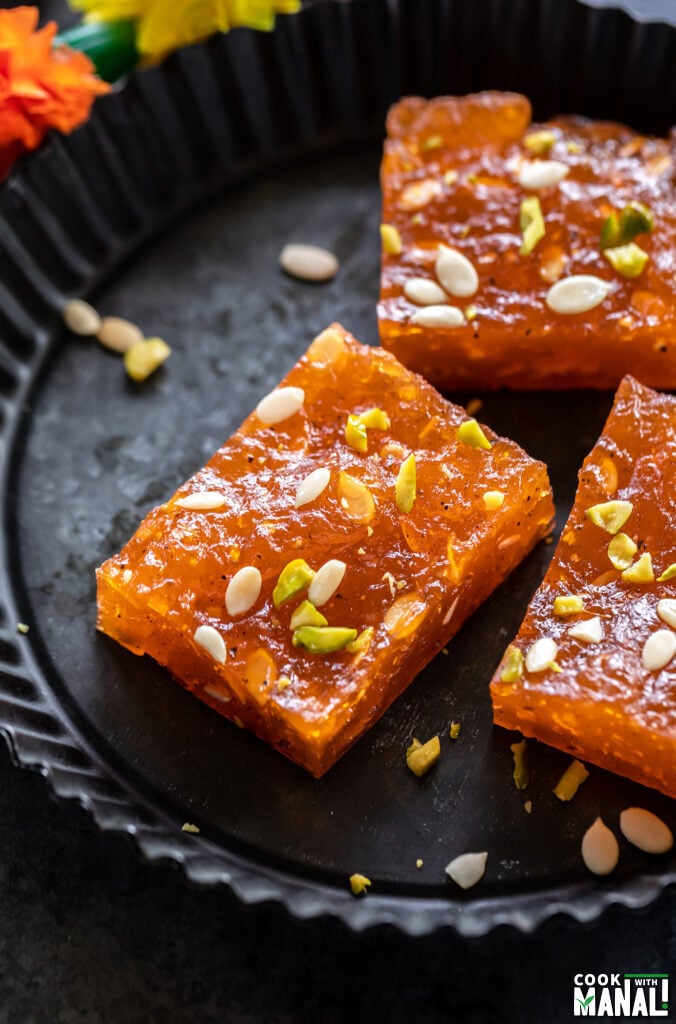
Karachi Halwa was one of my favorite sweets while growing up (along with besan ladoo and rasmalai and motichoor ladoo). I remember I would beg mom to get me a few pieces of Karachi halwa from this one particular sweet shop in Noida (my hometown). Mom would always get those exclusively for me and I would devour them in no time. It was like a special treat which I looked forward to all year long.
This halwa wasn’t one of those sweets which was super common or one that you would find in every other Diwali box. But I absolutely loved it. In Delhi and around, we always called it Karachi Halwa but I have heard that it’s also known as Bombay Halwa in some parts of the country.
The halwa that mom got for me from sweet shop was always individually wrapped and orange in color. It was rich, chewy and I used to relish every bite. Fortunately, my husband shares my love for Karachi halwa. For the longest time, my parents got this halwa for us whenever they visited us from India.
But now, I make it at home. It definitely takes some time to make this halwa. This is not one of those easy and quick recipes. It’s a labor of love and takes time and patience but if you are up for the challenge, let’s see how we make it.
Ingredients
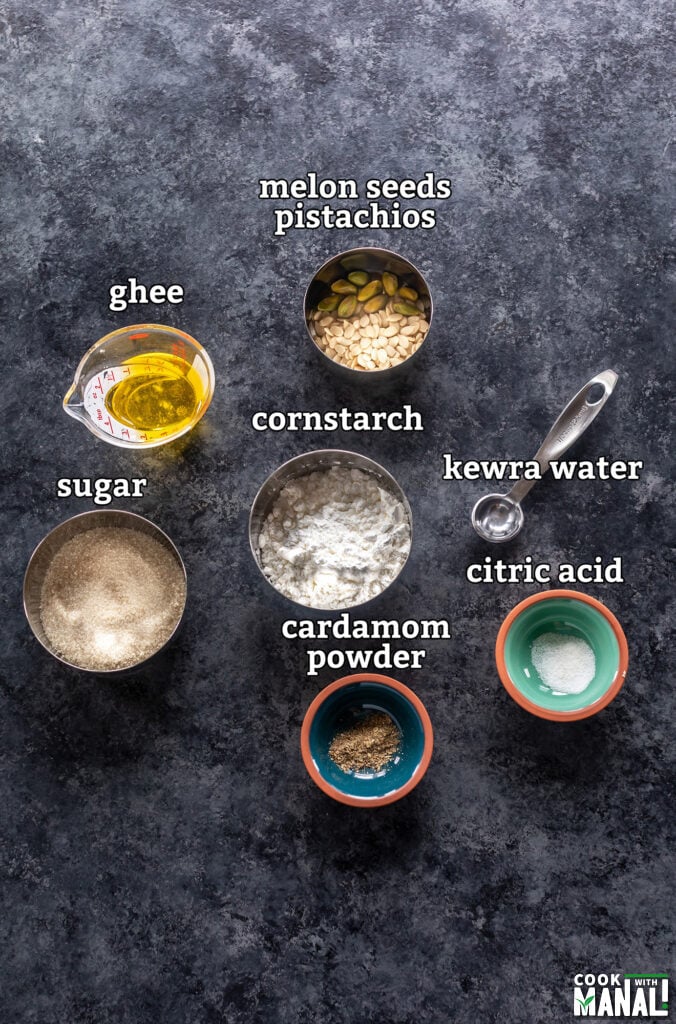
Cornstarch: this is the main ingredient for this halwa. Usually, we use cornstarch to thicken sauces and gravies but here it is the star ingredient. If you live in India, you can use corn flour, it’s the same thing.
Ghee: the halwa gets a lot of its flavor from ghee so I definitely recommend not skimping on it.
Melon seeds: whenever I have had Karachi halwa, it always had melon seeds in it and so I definitely recommend adding it for that authentic look and taste.
Citric acid: this is to prevent crystallization of the sugar, you can replace it with lemon juice.
Food color: usually Karachi halwa is sold at sweet shops in orange or yellow food color. In Delhi, I always saw it in orange color and so that’s what I have used here. You can also use saffron to color it naturally.
Tips to Make Perfect Chewy Karachi Halwa
One of the most important things about Karachi halwa is its texture. It has to be chewy, not very chewy that you would break your teeth but chewy enough. I have made this halwa before where it didn’t turn out chewy. It tasted good but it was just soft and that’s not what you expect from Karachi halwa.
But over time, I have perfected this recipe of Karachi Halwa which I am excited to share with you guys. Here are some things which you should keep in mind.
- Preferably use a non-stick pan. You can make this halwa in a regular steel pan as well, however because there’s so much stirring for a very long time, using non-stick is a good idea.
- Remember to add lemon juice or citric acid to the sugar when it’s dissolving. This will prevent crystallization of sugar and make sure your halwa turns out smooth in the end.
- Add ghee, 1 tablespoon at a time. Do not add all the ghee at once. This way, the cornstarch absorbs ghee nicely before you add more.
- Look out for change in consistency of the halwa. It will be smooth and soft at first, becoming thicker and thicker as you cook. And after it has reached the right stage, it will not be smooth. It will come together as a ball and will be somewhat difficult to stir. It will look and feel like rubber.
- There are 2 most important things to look for when checking if the halwa is done or not. 1) Ghee will leave from the sides of the mixture. It took me around 1 hour to reach this stage. 2) When you take a small portion from the mixture and pull it, you will see that it stretches like a rubber (see pictures below). If it breaks and there’s no stretching, it means you have to cook it more.
There’s no shortcut here and you will need to stir this for a long time to achieve this consistency. The timing may vary depending on so many things, so definitely keep an eye on the texture and whether you are able to stretch it or not.
Step by Step Instructions
1- Start by taking 1 cup (140 grams) of cornstarch in a bowl. Add 3 & 1/4 cups of water (780 ml) of water.
2- Stir very well until cornstarch dissolves. Set this aside.
3- To a pan on medium heat, add 2 cups (400 grams) of sugar. To that add the remaining 1/2 cup (120 ml) of water. Stir and let the sugar dissolve completely.
4- Add 1/4 teaspoon citric acid as the sugar is dissolving. This helps prevent crystallization. You can also add 1 tablespoon lemon juice in place of citric acid.
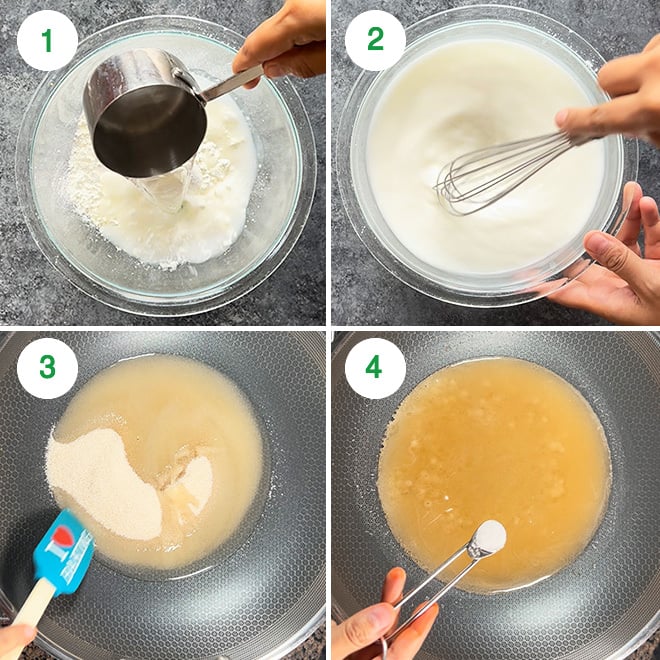
5- Then lower the heat and add the prepared cornstarch mix (stir it before adding else cornstarch settles at the bottom when left unattended).
6- After around 8 to 9 minutes, the mixture will start forming lumps. It will seem very lumpy, but don’t worry and just keep stirring.
7- In just a few more minutes (after around 13 to 14 minutes of adding the cornstarch mix to the pan), the mixture will turn smooth and quite thick.
8- Now, we start adding ghee, 1 tablespoon at a time.
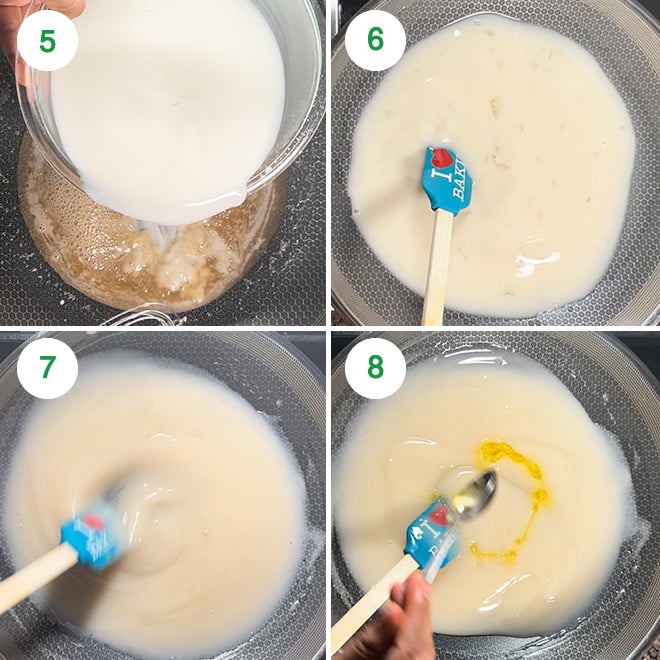
9- Add 1 tablespoon and mix until ghee is completely absorbed by the mixture. Once it’s completely absorbed only then add the next tablespoon.
10- Add around 6 to 7 tablespoons of ghee in around 10 minutes total time, stirring well after each tablespoon addition. You will notice the mixture will become quite shiny at this stage and also become thicker.
11- Add food color at this point (I added a little orange color which I dissolved in 1/2 tablespoon water and then added to the pan). Stir 5 more mins after adding the color. You can skip adding the color or add saffron for natural color. This is how Karachi Halwa was sold in shops in Delhi and so I went for that orange color.
12- Then add 2 tablespoons of melon seeds.
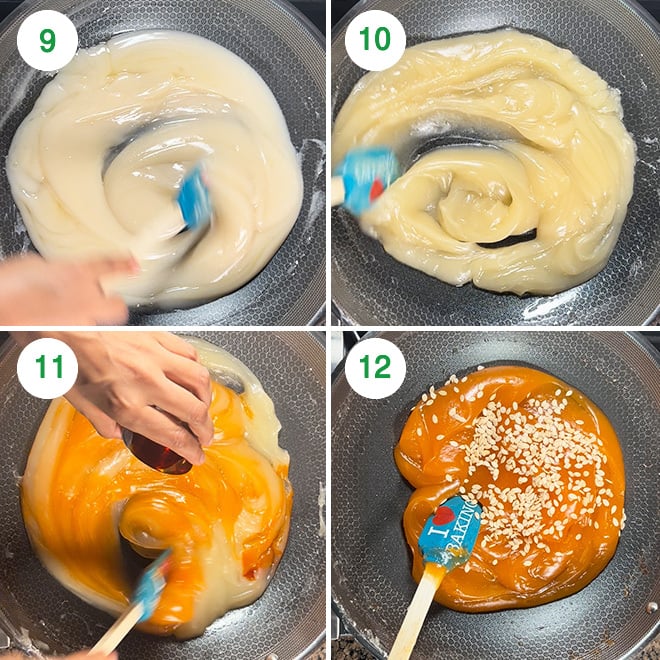
13- Cook for 10 more minutes, stirring often. Remember the heat is low.
14- Add 1 teaspoon cardamom powder and a few splashes of kewra water and stir. You can also use rose water in place of kewra water.
15- Keep cooking and stirring, you will notice the texture of halwa change.
16- After 1 hour of cooking, you will see ghee leaving from the sides of the mixture and start turning like rubber. I increased heat to medium for the last 10 minutes of cooking but kept stirring regularly.
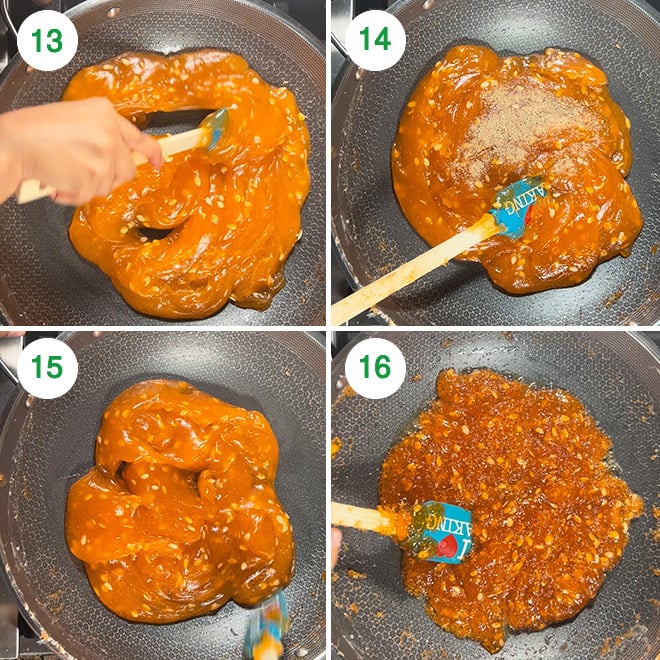
17- The mixture will not be smooth anymore but rather difficult to stir. It took me around 1 hour and 20 minutes to reach this stage.
18- To test if the halwa is done: take a small portion of the mixture and pull it apart (see picture no. 18 for reference). It should stretch like rubber, if not it needs to be cooked more. Look for this texture rather than the mentioned timing because timing can vary depending on thickness of the pan, intensity of heat and quality of ingredients being used. It can take you anywhere between 1 hour to 1 hour 20 minutes to reach this stage.
You have to cook until this stage for the halwa to turn chewy. If you don’t cook until this stage then halwa will be soft and not chewy.
19- Once you have reached that consistency, remove from heat and transfer the mixture to a greased pan lined with parchment paper. I used an 8-inch square pan. Top with more melon seeds and chopped nuts like pistachios or cashews. Let it set for 2 to 3 hours.
20- Then cut into pieces, you can cut them into small or big pieces. In Delhi we would usually have these big rectangular pieces at sweet shops. You can wrap individual pieces in plastic sheets to make them look like how you would find them at sweet shops in India.
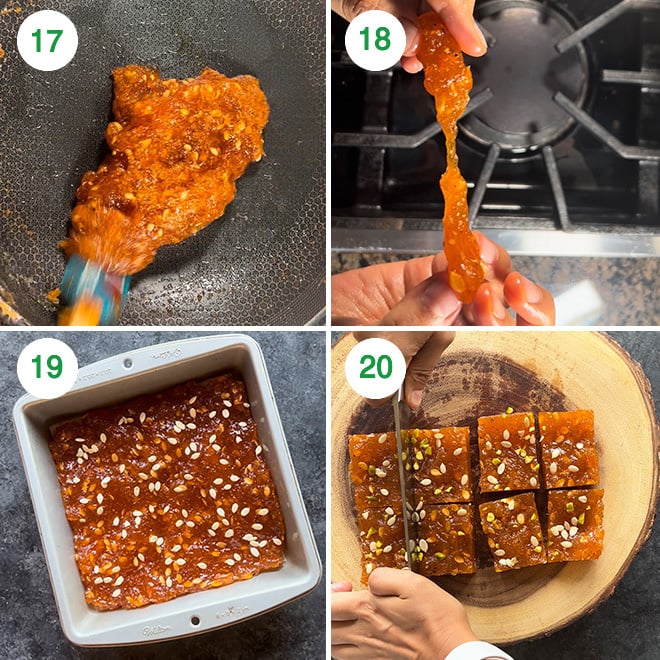
Storage
I like storing karachi halwa at room temperature. It can be stored at room temperature for 2 to 3 weeks easily or even more but it never lasts that long in my house!
Can I Use Corn flour?
In India, we get cornstarch as corn flour- the white powder like flour and not the yellow flour which is actually different. And yes if you live in India, you can totally use corn flour in this recipe. It will work exactly the same way.
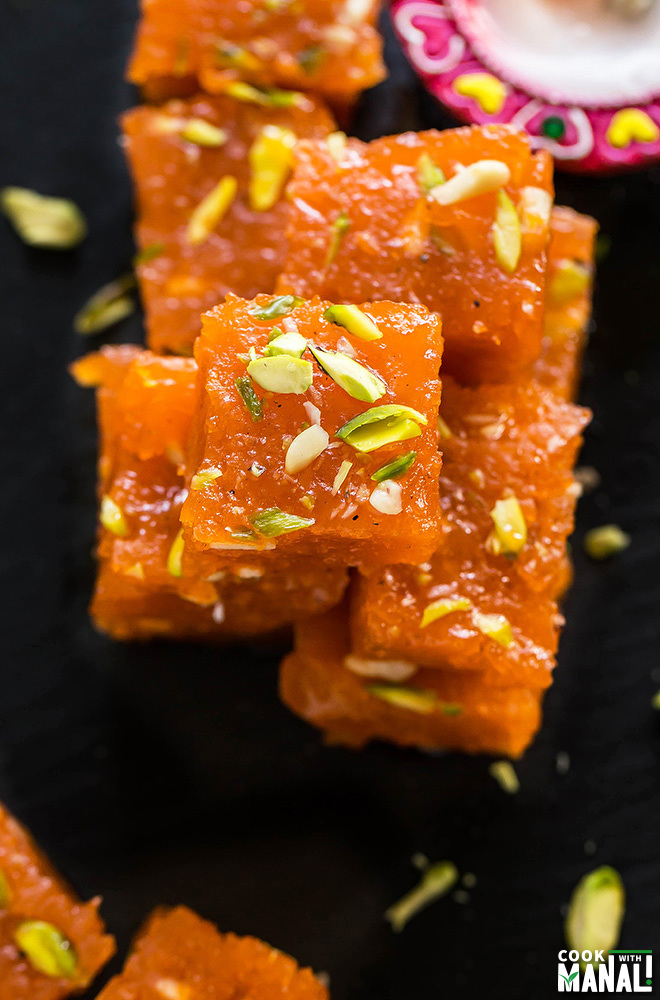
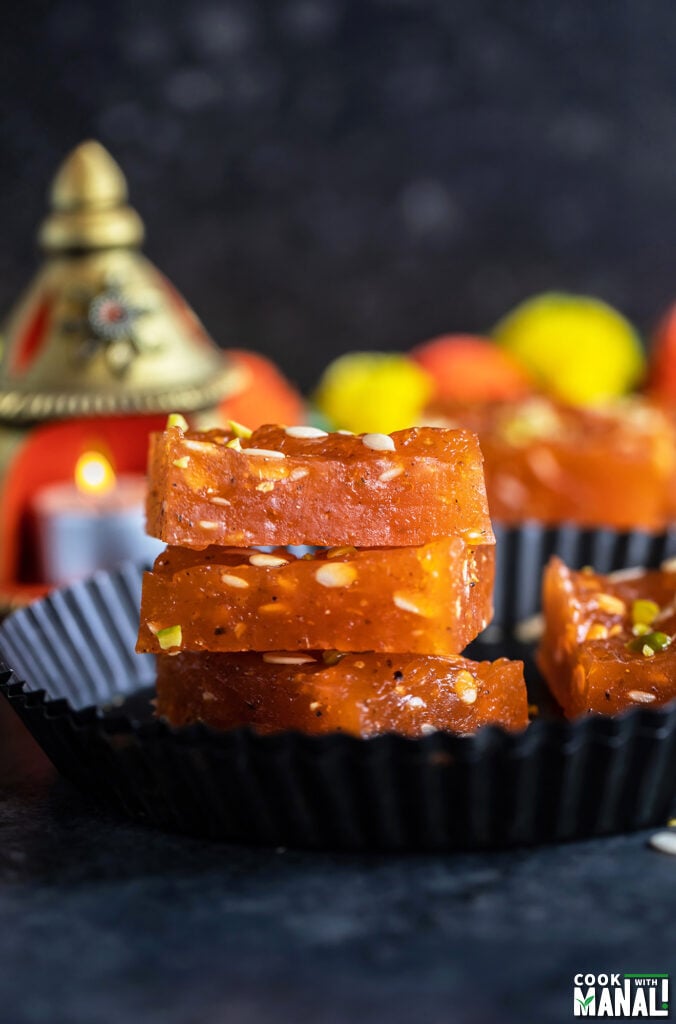
Tips & Notes
- This halwa is not very sweet. I have used 2 cups (400 grams) of sugar here. If you wish to make it sweeter, I would recommend adding 50 gram more of sugar to make it 450 grams of sugar in total.
- You can flavor this halwa with saffron as well. In fact if you don’t want to use food color, just bloom some saffron strands in warm water and add that to the mixture. I have used orange food color to make it like how it is sold in sweet shops in Delhi and around.
- Rose water and be used in place of kewra water.
- The most important thing to get the perfect texture is to cook the mixture until it reaches the desired consistency. Please read all the tips before you start making the halwa. Once you reach the desired stage, immediately remove the mixture from heat. Over-cooking from this point may result in a super chewy halwa, which you don’t want.
- This recipe can be halved, the cooking time will decrease in that case.
If you’ve tried this Recipe then don’t forget to rate the recipe! You can also follow me on Facebook, Instagram to see what’s latest in my kitchen and on YouTube to watch my latest videos.
This post has been updated from the recipe archives, first published in October 2016.
Karachi Halwa
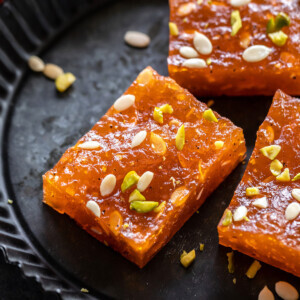
Ingredients
- 1 cup cornstarch 140 grams, or use cornflour
- 3 + 3/4 cup water 900 ml, divided
- 2 cups granulated white sugar 400 grams
- 1/4 teaspoon citric acid or use 1 tablespoon lemon juice
- 6-7 tablespoons ghee 90-105 ml
- orange food color mixed with 1/2 tablespoon water
- 2 tablespoons melon seeds + more to garnish
- 1 teaspoon cardamom powder
- splashes kewra water or rose water
- chopped pistachios to garnish
Instructions
- Start by taking cornstarch in a bowl. Add 3 & 1/4 cups of water (780 ml) of water. Stir very well until cornstarch dissolves. Set this aside.
- To a pan on medium heat, add 2 cups (400 grams) of sugar. To that add the remaining 1/2 cup (120 ml) of water. Stir and let the sugar dissolve completely. Add 1/4 teaspoon citric acid as the sugar is dissolving. This helps prevent crystallization.
- Then lower the heat and add the prepared cornstarch mix (stir it before adding else cornstarch settles at the bottom when left unattended). After around 8 to 9 minutes, the mixture will start forming lumps. It will seem very lumpy, but don't worry and just keep stirring.
- In just a few more minutes (after around 13 to 14 minutes of adding the cornstarch mix to the pan), the mixture will turn smooth and quite thick. Now, we start adding ghee, 1 tablespoon at a time.
- Add 1 tablespoon and mix until ghee is completely absorbed by the mixture. Once it's completely absorbed only then add the next tablespoon. Add around 6 to 7 tablespoons of ghee (I added 7 tablespoons) in around 10 minutes total time, stirring well after each tablespoon addition. You will notice the mixture will become quite shiny at this stage and also become thicker.
- Add food color at this point (I added a little orange color which I dissolved in 1/2 tablespoon water and then added to the pan). Stir 5 more mins after adding the color. You can skip adding the color or add saffron for natural color.
- Then add 2 tablespoons of melon seeds. Cook for 10 more minutes, stirring often. Remember the heat is low.
- Add 1 teaspoon cardamom powder and a few splashes of kewra water and stir. You can also use rose water in place of kewra water. Keep cooking and stirring, you will notice the texture of halwa change.
- After 1 hour of cooking, you will see ghee leaving from the sides of the mixture and start turning like rubber. I increased heat to medium for the last 10 minutes of cooking but kept stirring regularly. The mixture will not be smooth anymore but rather difficult to stir. It took me around 1 hour and 20 minutes to reach this stage.
- To test if the halwa is done: take a small portion of the mixture and pull it apart (see picture no. 18 above for reference). It should stretch like rubber, if not it needs to be cooked more. Look for this texture rather than the mentioned timing because timing can vary depending on thickness of the pan, intensity of heat and quality of ingredients being used. It can take you anywhere between 1 hour to 1 hour 20 minutes to reach this stage.You have to cook until this stage for the halwa to turn chewy. If you don't cook until this stage then halwa will be soft and not chewy.
- Once you have reached that consistency, remove from heat and transfer the mixture to a greased pan lined with parchment paper. I used an 8-inch square pan. Top with more melon seeds and chopped nuts like pistachios or cashews. Let it set for 2 to 3 hours.
- Then cut into pieces, you can cut them into small or big pieces. In Delhi we would usually have these big rectangular pieces at sweet shops. You can wrap individual pieces in plastic sheets to make them look like how you would find them at sweet shops in Delhi.
Notes
- This halwa is not very sweet. I have used 2 cups (400 grams) of sugar here. If you wish to make it sweeter, I would recommend adding 50 gram more of sugar to make it 450 grams of sugar in total.
- You can flavor this halwa with saffron as well. In fact if you don’t want to use food color, just bloom some saffron strands in warm water and add that to the mixture. I have used orange food color to make it like how it is sold in sweet shops in Delhi and around.
- The most important thing to get the perfect texture is to cook the mixture until it reaches the desired consistency. Please read all the tips before you start making the halwa. Once you reach the desired stage, immediately remove the mixture from heat. Over-cooking from this point may result in a super chewy halwa, which you don’t want.
- This recipe can be halved, the cooking time will decrease in that case.
- You can increase the heat to medium towards the last 10 to 15 minutes of cooking to speed up the process a little. Just remember to not burn the halwa.
- Please read the steps and all the tips carefully before making the halwa. Unfortunately, there’s no shortcut here and you will have to cook the halwa for a long time to achieve the texture.
Nutrition
Nutrition information is automatically calculated, so should only be used as an approximation.
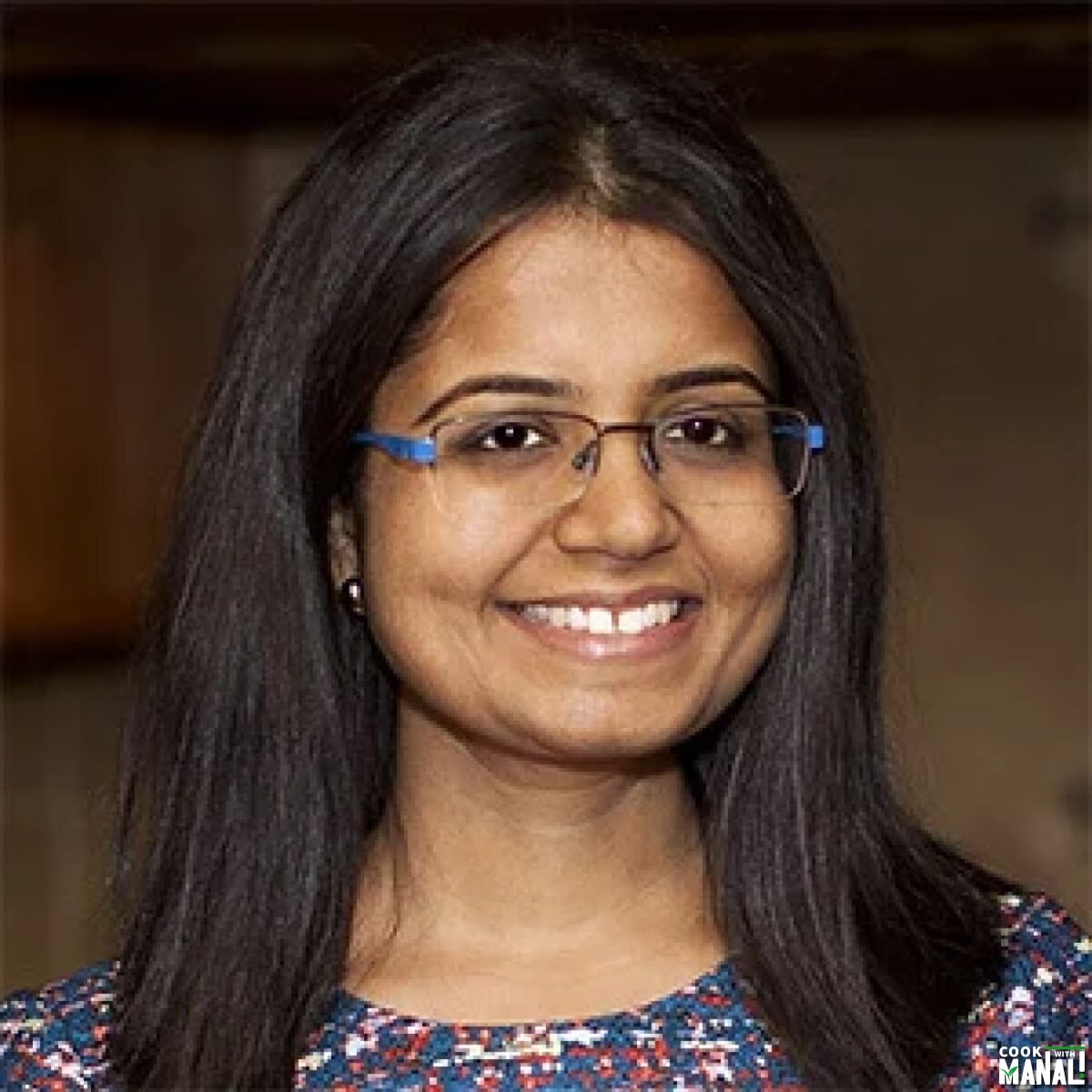
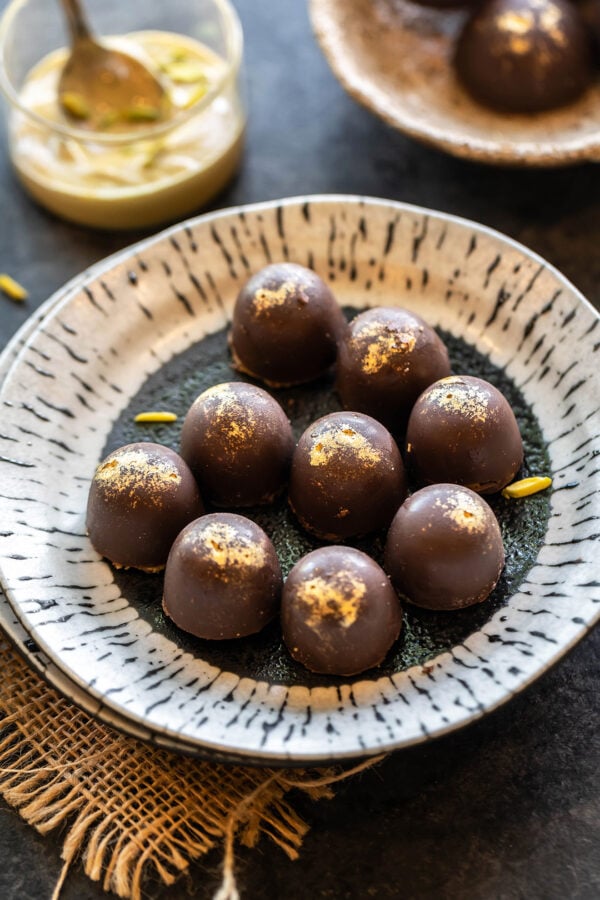
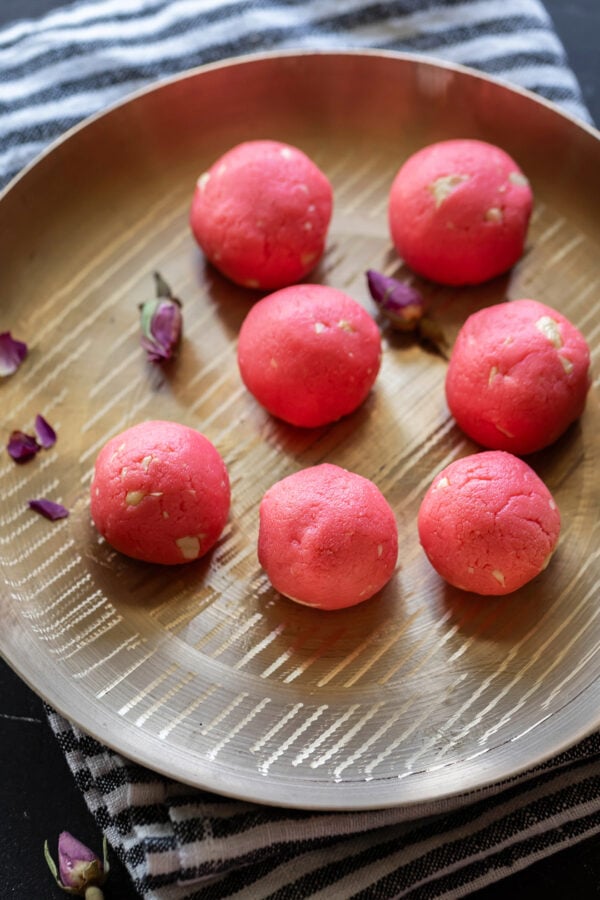
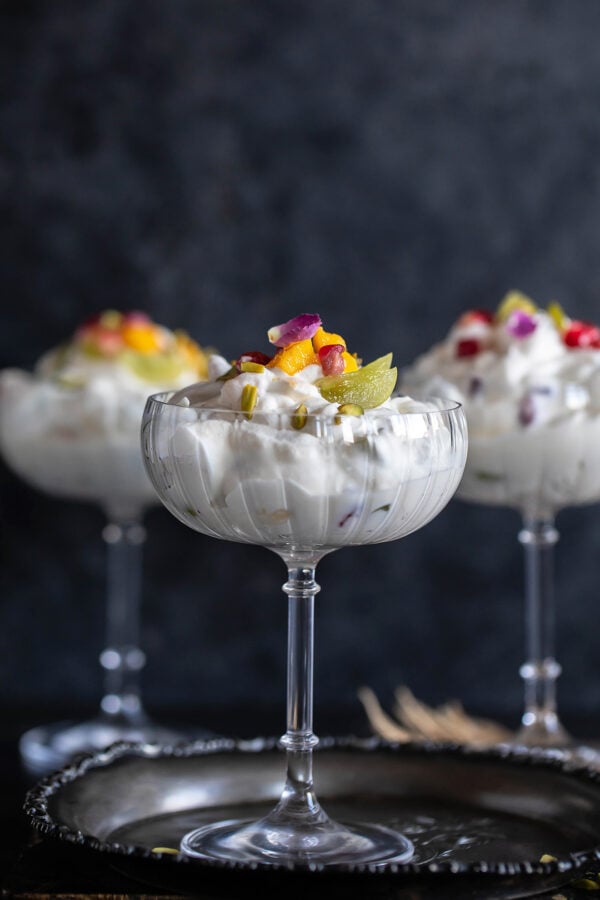
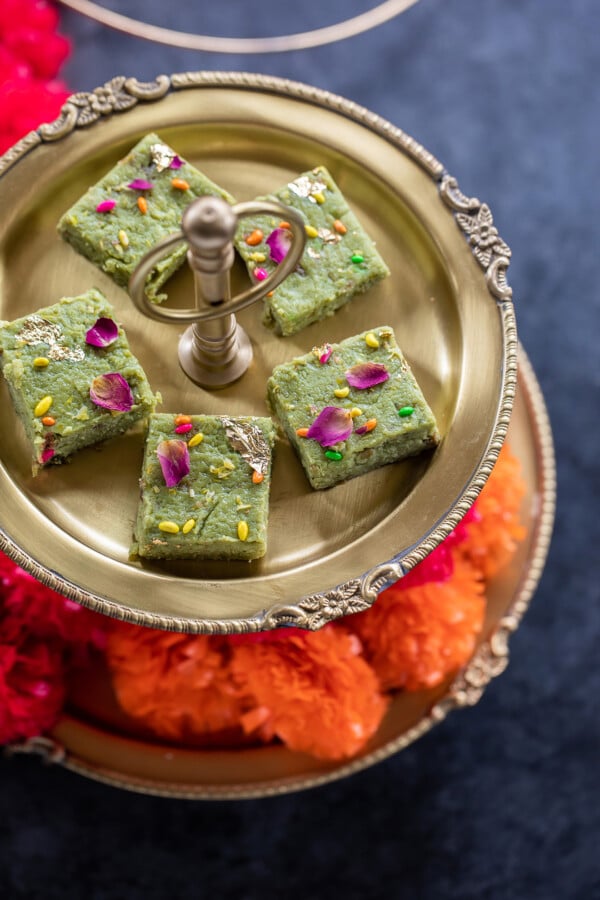









Very good. I’ll follow this recipe. When I go to my home country, Sri Lanka, I can make it.
Hello Manali, my name is Suresh and I am from UK, I was pleased that you have made a very explicit documentaion and procedure on this Karachi Halwa from start to finish, I have seen so many video on youtube and in opinion so much is very full of hit and miss attitude and so confusing when they start giving units of measurements all mixed up shody way, like bit of this!, pinch of that!, approximately! units that should be given in Litres are in grams and visa versa!! speaking vocally not clear and at the speed light, just do not make sence and also the final product do not show the tecture and stickyness as if they are afraid to show. So credit to you and well done.
Hi ! You have given very clear instructions painstakingly. I particularly note your emphasis on its final rubbery texture rather than sticking on to time. There are several variables with which a reader might try and might not reach the right Halwa. I remember to have had it in bottle green color with pistachio broken nuts. It is a useful effort on your part.
thank you, I am glad you found it useful.
Dear Manali,
Please let me know the shelf life of this wonderful sweet. Thanks to you for giving such simple yet yummy sweet recipe.
it should be okay in the refrigerator for 5 days!
Nice recipe. Definitely worth trying. Pictures look tempting and brings water to the mouth.
Such a lovely recipe! Nice photos too ♥
Why its called Karachi halwa if its Indian sweet Manali?? Karachi is in Pakistan dear! Nice share☺
It’s also called Bombay Halwa so I am not sure about it’s origin Afshan 🙂 I grew up eating it so I just assumed it’s an Indian sweet. Whether it’s an Indian or Pakistani sweet doesn’t matter, all that matters is that it’s delicious! Thanks for dropping by 🙂